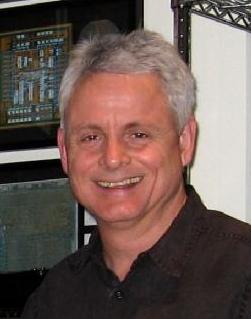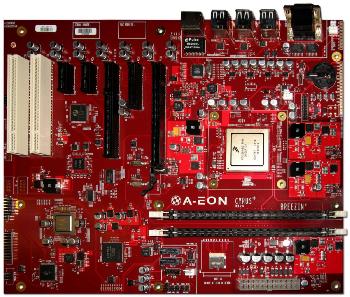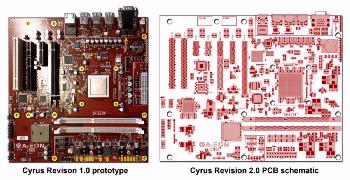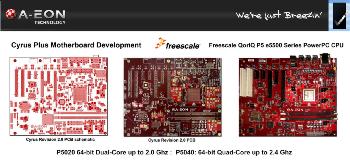Suivez-nous sur X

|
|
|
0,
A,
B,
C,
D,
E,
F,
G,
H,
I,
J,
K,
L,
M,
N,
O,
P,
Q,
R,
S,
T,
U,
V,
W,
X,
Y,
Z,
ALL
|
|
0,
A,
B,
C,
D,
E,
F,
G,
H,
I,
J,
K,
L,
M,
N,
O,
P,
Q,
R,
S,
T,
U,
V,
W,
X,
Y,
Z
|
|
0,
A,
B,
C,
D,
E,
F,
G,
H,
I,
J,
K,
L,
M,
N,
O,
P,
Q,
R,
S,
T,
U,
V,
W,
X,
Y,
Z
|
|
A propos d'Obligement

|
|
David Brunet

|
|
|
|
Interview with Trevor Dickinson
(Interview conducted by David Brunet - July 2013)
|
|
 Trevor Dickinson funded a company in mid 2009, called A-EON Technology, with the purpose of developing new hardware for AmigaOS
4 and beyond. Since this time, Trevor became a key player in the Amiga scene. It's now time to see his next projects.
Trevor Dickinson funded a company in mid 2009, called A-EON Technology, with the purpose of developing new hardware for AmigaOS
4 and beyond. Since this time, Trevor became a key player in the Amiga scene. It's now time to see his next projects.
 In mid-2009, you have
funded A-EON Technology with two other persons: Tony Morley and Ben Hermans. They're not in the "new" A-EON. Why? In mid-2009, you have
funded A-EON Technology with two other persons: Tony Morley and Ben Hermans. They're not in the "new" A-EON. Why?
A-EON Technology CVBA was a Belgian company originally formed in 2009 to develop modern hardware for the AmigaOS.
Initially I had several business partners but eventually I ended up managing the company and funding most of the
development and manufacturing costs. With the AmigaOne X1000 project successfully completed there was no need
for a company based in Belgium.
Having successfully completed the AmigaOne X1000 development, I decided I would like to continue funding new hardware
and software for the benefit of the whole Amiga community. As a result, I backed a new UK company, A-EON Technology Ltd,
in partnership with Matthew Leaman, who is also the M.D. (managing director) of AmigaKit, a successful international
Amiga retailer servicing both the Classic and next generation community. With Matthew's assistance, we hope that all
the new hardware and software projects will be undertaken on a sustainable and commercially viable basis. As a result,
we have pre-funded a number of software projects which should benefit AmigaOS 4.1 users. These included RadeonHD drivers,
the Warp3D drivers for Radeon HD graphics cards, Catweasel
MK2 drivers for the AmigaOne X1000 and other AmigaOne computers
and the Libre Office suite. We are also pre-funding a number of hardware and software developments for Classic Amiga and
Next Generation Amiga users. Watch this space.
 The new A-EON Technology
is managed with Matthew Leaman (director of AmigaKit). Do you plan to incorporate other persons or to expand the company? The new A-EON Technology
is managed with Matthew Leaman (director of AmigaKit). Do you plan to incorporate other persons or to expand the company?
Interesting question. We are not planning to expand the A-EON management at this time, although we are looking to forge
close working relationships with other companies and individuals.
 The first goal of
A-EON Technology was to provide a high-end machine, the AmigaOne X1000, for the AmigaOS 4. What is your assessment
of the whole AmigaOne X1000 adventure? The first goal of
A-EON Technology was to provide a high-end machine, the AmigaOne X1000, for the AmigaOS 4. What is your assessment
of the whole AmigaOne X1000 adventure?
Success can be measured in many ways. When I started the project I set myself a number of goals with the ultimate
objective of creating the most powerful custom built "Next Generation" AmigaOS computer released to date and from
a technical viewpoint the AmigaOne X1000 project has been very successful.
However, the biggest cost in small volume manufacturing is the "None recurring Engineering" development charge (NRE).
This is the labour and material costs associated with developing the product and manufacturing the first prototypes.
Inevitably you will also need to make several revision designs along with new prototypes. If you are building hundreds
of thousands or millions of units the NRE cost is "almost" negligible when spread over the large number of units sold.
It is a very different matter with small volume manufacturing for any market.
We took a phased approach to developing the Nemo
motherboard for the A1-X1000. The first step was a proof-of-concept and
we pre-funded US$115K for initial development and prototyping. Five prototypes were manufactured for stress testing
and porting AmigaOS 4. After review we took the decision to make a number of minor design improvements and create a
revision 2 motherboard. Revisions cost more time and money and delay. Prototypes are also very expensive because they
are made in very small volumes and can cost up to US$5000 per board.
Another five Revision 2 prototype motherboards were produced for testing and driver work. Why so few boards you might ask?
Because you want to make sure there are no major hardware surprises before moving to production manufacturing. As it was,
we ended up creating a revision 2.1 board with the associated additional cost. Also, due to supply issues, we a pre-funded
a batch of P.A. Semi CPU's (PA6T-1682M) for the beta test program and first batch of "First Contact" AmigaOne X1000 systems. That
was before we started taking deposits for the beta test programme.
All-in-all the NRE costs to produce the original prototypes, revision 2 modifications and new prototypes for hardware
testing burnt almost $200K in pre-funding. That is the reality of the situation. If we could sell 200,000 units that
would only add one dollar to the sales price. However, if we only sold 200 that that would add US$1000 to the sales
price. Also it did not help that Apple purchased P.A. Semi and closed down production and the prices of the CPU almost
doubled. The initial costings were based on a CPU price of $500 each. Since Apple ceased production the CPU prices have
varied between ~$600 and $1000 per unit. However, we have absorbed these price increases and have not passed them on
to the customer. So was the project a commercial success? No, I will not recover my original investment. Do I consider
it a technical success? Most definitely yes.
Having said all of that, the Nemo development also helped established the foundation for future projects and the experience
has shown me that there is still a strong demand among Amiga enthusiasts for a custom built "Next Generation" machine. As
long as that demand remains I will continue to help fund new hardware and software developments.
 How many AmigaOne X1000
was produced since the beginning? How many AmigaOne X1000
was produced since the beginning?
More that 200 and less that 2,000. ;-)
 One of the main negative
comment about the AmigaOne X1000 is its price. Is it possible to drop the price of this machine? One of the main negative
comment about the AmigaOne X1000 is its price. Is it possible to drop the price of this machine?
No, for all the reasons given in my answer to third question above.
 Some weeks ago, your
hardware partner Varisys
was acquired by Ultra-Electronics. Were you aware of this acquisition before the press release?
Were you worried, at the beginning, for your future relations with Varisys? Some weeks ago, your
hardware partner Varisys
was acquired by Ultra-Electronics. Were you aware of this acquisition before the press release?
Were you worried, at the beginning, for your future relations with Varisys?
We were not worried. When the news broke Varisys contacted us to reassure us that they valued our unique and unusual
business. They are building more Nemo motherboards, the Cyrus Plus project is ongoing and we are in the process of
contracting them for another development.
 At the show Silicon Dreams/VCF 2013,
you showed two prototypes named Cyrus/Cyrus+. Are there the motherboards of a future AmigaOne X2000? What are their features? At the show Silicon Dreams/VCF 2013,
you showed two prototypes named Cyrus/Cyrus+. Are there the motherboards of a future AmigaOne X2000? What are their features?
The Cyrus development is the future replacement for the Nemo motherboard when the supply of P.A. Semi CPUs finally dries
up or the price becomes commercially unviable. The Cyrus board was the original Revision 1.0 prototype and was
completed towards the end of last year. Cyrus Plus is the Revision 2.0 board which includes additional PCIe and PCI slots.
The Cyrus design is based on the Freescale P5020 CPU which is a dual-core 64-bit PowerPC SoC. It also supports DDR3 RAM
and includes an improved Xena/Xorro combination.
 Cyrus Plus prototype
Cyrus Plus prototype
 Cyrus revision 1.0
Cyrus revision 1.0
 Cyrus Plus revision 2.0
Cyrus Plus revision 2.0
Note: The name for systems based on the Cyrus Plus board/CPU combinations has not yet been finalised. For simplicity,
internally we are referring to the P5020 model as the AmigaOne-X2000 and the P5040 model as the AmigaOne-X4000. However, this may
change by the time the commercial models are available for sale, which won't be for quite some time.
 Xena/Xorro will be also
on these boards. But there are not very useful for now. What do you plan to develop this area? Xena/Xorro will be also
on these boards. But there are not very useful for now. What do you plan to develop this area?
There are several projects in the works or being planned to rectify this issue. There are people actually working on
Xorro and Xena applications, but to answer your question, again it all comes down to volume. We had hoped that some
hardware developers might design special Xorro applications for the AmigaOne X1000 and we are still hopeful that this
will happen. In the meantime, AmigaOne X1000 beta testers can and have purchased Xorro development boards to create their
own projects and it is our intention to commercialise one or two of these projects in the future. In addition, we are
including Xena/Xorro capability on the future Cyrus hardware.
 Do you plan to make a
PCI card with Xena/Xorro? (for example to be used on other Amiga NG). Do you plan to make a
PCI card with Xena/Xorro? (for example to be used on other Amiga NG).
At this moment in time we are concentrating on our own "Next Generation Amiga" hardware, but we will revisit this
question once we finish the current projects.
 Why did you choose the
P5020 processor? Why did you choose the
P5020 processor?
Recommendations from Varisys coupled with the price, performance and Freescale's stated commitment to a long term (10 years)
production cycle. Also the pin compatibility with the quad-core P5040 makes a 2.4GHz model an attractive proposition for
the ultimate "Next Generation Amiga".
 What means the name "Cyrus"?
And the name "Breezin'" that we can see on the motherboard? What means the name "Cyrus"?
And the name "Breezin'" that we can see on the motherboard?
Cyrus is the codename for the new mother board and as with the Nemo board is based on a character from Jules Verne's novel,
"The Mysterious Island". Captain Nemo and Cyrus Smith are just two of the characters and there are plenty of others in
the book! ;-)
In keeping with the long held Commodore tradition we added a B52 song title to the motherboard. On the Nemo motherboard it
was "Keep this party going" and on the Cyrus boards it is "Breezin'". Again, there are a lot of B52 song titles left! ;-)
 What are the estimated
price the motherboards? Estimated price of the whole machines? And is there a date of release? What are the estimated
price the motherboards? Estimated price of the whole machines? And is there a date of release?
It's really too early to provide firm information at this stage. Varisys are now putting the Cyrus Plus board through
the same rigorous testing programme that the Nemo board underwent. Once this is completed we will build a small batch
of boards (~10/12) for developers to iron out any hardware bugs. After that, the next phase will be to produce a limited
run of ~50 boards for a reduced beta test programme. All being well the beta test boards will be available by the end of
the year. Commercial boards will follow some time after that. As for pricing. we are hoping that the new Cyrus Plus board
with the P5020 will be slightly less expensive than the Nemo board, but no promises at this stage. Pricing for the P5040
version will depend on the cost and availability of the Freescale CPU.
 Will you launch a beta-test
program as with the AmigaOne X1000? Will you launch a beta-test
program as with the AmigaOne X1000?
Yes, it proved very successful with the AmigaOne X1000. However, the number will be limited to around 50 beta testers as
I mentioned above.
 Do you plan to support
also MorphOS on this new machine? Do you plan to support
also MorphOS on this new machine?
As with Nemo, the Cyrus Plus board has been developed to run the AmigaOS but I would personally like to see the new boards
support all the Next Generation Operating Systems including PowerPC Linux distributions. The more the merrier.
 Once the "AmigaOne X2000"
on sale, will you continue the production of the X1000? Once the "AmigaOne X2000"
on sale, will you continue the production of the X1000?
We will continue to manufacture AmigaOne X1000 as long as the demand continues and we can source P.A. Semi CPUs at a
"reasonable" price. Incidentally, another batch of Nemo motherboards are being processed by Varisys at this very moment.
 What is the story behind
the netbook on AmigaOS 4? Are you the initiator of this project? What is the story behind
the netbook on AmigaOS 4? Are you the initiator of this project?
No, I was not the original initiator of the AmigaOS 4 netbook project. When I realised that, due to a number of issues,
it looked like the development effort had stalled I contacted the Chinese manufacturer to try and kickstart the project.
Timothy De Groote of Hyperion Entertainment provided a prototype LimeBook for us to test and following some prolonged
email negotiations with the manufacturer we managed to get a reasonable price and volume commitment.
The LimeBook itself is not a bad little machine, even if it is somewhat underpowered and the keyboard is a little flimsy.
However, after performing detailed cost analysis which included NRE set-up costs, OS porting costs, driver development,
branding, import costs and AmigaOS 4 licences we could not get the end user price much under £500 (VAT inclusive), and
that is with based on ordering and pre-paying for batches of 1000 units at a time with a very minimal sales margin added.
We think that is far too expensive for such an underpowered machine. As far as we are aware the project has not been
officially cancelled. However, we are now leaning in another direction altogether. ;-)
 Aside your activities
about hardware, you also support software projects. What is the status of the Warp3D drivers for Radeon HD? And the LibreOffice port? Aside your activities
about hardware, you also support software projects. What is the status of the Warp3D drivers for Radeon HD? And the LibreOffice port?
Yes, we are increasing our support for software projects and new Classic Amiga hardware projects. Expect to see
news of these in the near future. Warp3D has proven more difficult and taken longer than expected. I had hope to
have a demo available for the recent Silicon Dreams show. However, the Warp3D work has helped accelerate the Gallium 3D
development.
Libre Office was always slated as a long term project. The developer continues to make good progress and we will make an
announcement as soon as the work is done.
 We know your are a collector
of Amiga/Commodore computers. How many of them do you have now? What was the last entries in your collection? We know your are a collector
of Amiga/Commodore computers. How many of them do you have now? What was the last entries in your collection?
I actually counted them recently for another interview and the grand total is now 180. My latests acquisitions include an
A3000 and CD32 which I was given for free. However, I've just purchased a DraCo Cube which should be winding it's
way to New Zealand as we speak! :-)
 Do you still search for a
particular model? Which computer of your collection you never boot to avoid to damage it? ;-) Do you still search for a
particular model? Which computer of your collection you never boot to avoid to damage it? ;-)
I'm still looking for a Commodore 4000T model and would really like to get my hands on an Amiga 3200. I'm also very
interested in some of the unreleased post Commodore "Powered by Amiga" clones like the BoXeR and Power 5000. Matthew
Leaman has promised to supply me with an Index Access Cube, but I'm still waiting! ;-)
I try to boot all my machines regularly, as time allows.
 Is there a question I
didn't asked you, and that you want to answer to? Is there a question I
didn't asked you, and that you want to answer to?
Yes, why do I do it, am I crazy! No, I am an Amigaholic! ;-) Seriously though, knowing what is coming through or
planned on the hardware front the emphasis now needs to shift focus to software and content.
 Trevor in Italy with ACube and Cloanto
Trevor in Italy with ACube and Cloanto
 A last message for the
Amiga community? A last message for the
Amiga community?
Thank you for the opportunity of sharing my Amiga passion (obsession) with your readers.
|


 Trevor Dickinson funded a company in mid 2009, called A-EON Technology, with the purpose of developing new hardware for AmigaOS
4 and beyond. Since this time, Trevor became a key player in the Amiga scene. It's now time to see his next projects.
Trevor Dickinson funded a company in mid 2009, called A-EON Technology, with the purpose of developing new hardware for AmigaOS
4 and beyond. Since this time, Trevor became a key player in the Amiga scene. It's now time to see his next projects. In mid-2009, you have
funded A-EON Technology with two other persons: Tony Morley and Ben Hermans. They're not in the "new" A-EON. Why?
In mid-2009, you have
funded A-EON Technology with two other persons: Tony Morley and Ben Hermans. They're not in the "new" A-EON. Why? The new A-EON Technology
is managed with Matthew Leaman (director of AmigaKit). Do you plan to incorporate other persons or to expand the company?
The new A-EON Technology
is managed with Matthew Leaman (director of AmigaKit). Do you plan to incorporate other persons or to expand the company? The first goal of
A-EON Technology was to provide a high-end machine, the AmigaOne X1000, for the AmigaOS 4. What is your assessment
of the whole AmigaOne X1000 adventure?
The first goal of
A-EON Technology was to provide a high-end machine, the AmigaOne X1000, for the AmigaOS 4. What is your assessment
of the whole AmigaOne X1000 adventure? How many AmigaOne X1000
was produced since the beginning?
How many AmigaOne X1000
was produced since the beginning? One of the main negative
comment about the AmigaOne X1000 is its price. Is it possible to drop the price of this machine?
One of the main negative
comment about the AmigaOne X1000 is its price. Is it possible to drop the price of this machine? Some weeks ago, your
hardware partner Varisys
was acquired by Ultra-Electronics. Were you aware of this acquisition before the press release?
Were you worried, at the beginning, for your future relations with Varisys?
Some weeks ago, your
hardware partner Varisys
was acquired by Ultra-Electronics. Were you aware of this acquisition before the press release?
Were you worried, at the beginning, for your future relations with Varisys? At the show Silicon Dreams/VCF 2013,
you showed two prototypes named Cyrus/Cyrus+. Are there the motherboards of a future AmigaOne X2000? What are their features?
At the show Silicon Dreams/VCF 2013,
you showed two prototypes named Cyrus/Cyrus+. Are there the motherboards of a future AmigaOne X2000? What are their features? Xena/Xorro will be also
on these boards. But there are not very useful for now. What do you plan to develop this area?
Xena/Xorro will be also
on these boards. But there are not very useful for now. What do you plan to develop this area? Do you plan to make a
PCI card with Xena/Xorro? (for example to be used on other Amiga NG).
Do you plan to make a
PCI card with Xena/Xorro? (for example to be used on other Amiga NG). Why did you choose the
P5020 processor?
Why did you choose the
P5020 processor? What means the name "Cyrus"?
And the name "Breezin'" that we can see on the motherboard?
What means the name "Cyrus"?
And the name "Breezin'" that we can see on the motherboard? What are the estimated
price the motherboards? Estimated price of the whole machines? And is there a date of release?
What are the estimated
price the motherboards? Estimated price of the whole machines? And is there a date of release? Will you launch a beta-test
program as with the AmigaOne X1000?
Will you launch a beta-test
program as with the AmigaOne X1000? Do you plan to support
also MorphOS on this new machine?
Do you plan to support
also MorphOS on this new machine? Once the "AmigaOne X2000"
on sale, will you continue the production of the X1000?
Once the "AmigaOne X2000"
on sale, will you continue the production of the X1000? What is the story behind
the netbook on AmigaOS 4? Are you the initiator of this project?
What is the story behind
the netbook on AmigaOS 4? Are you the initiator of this project? Aside your activities
about hardware, you also support software projects. What is the status of the Warp3D drivers for Radeon HD? And the LibreOffice port?
Aside your activities
about hardware, you also support software projects. What is the status of the Warp3D drivers for Radeon HD? And the LibreOffice port? We know your are a collector
of Amiga/Commodore computers. How many of them do you have now? What was the last entries in your collection?
We know your are a collector
of Amiga/Commodore computers. How many of them do you have now? What was the last entries in your collection? Do you still search for a
particular model? Which computer of your collection you never boot to avoid to damage it? ;-)
Do you still search for a
particular model? Which computer of your collection you never boot to avoid to damage it? ;-) Is there a question I
didn't asked you, and that you want to answer to?
Is there a question I
didn't asked you, and that you want to answer to? A last message for the
Amiga community?
A last message for the
Amiga community?















